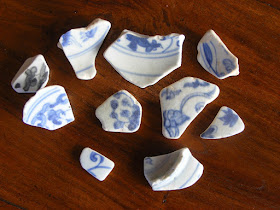In fact, typical blue-and-white Chinese porcelain shards occur at 10 locations along this south-eastern coast of South Africa. The wrecks believed to be associated with these sites are: Sao Joao 1552; Sao Bento 1554, Sao Thome 1589, Santo Alberto 1593, Sao Joao Baptista 1622, Sao Goncalo 1630, Nossa Senhore de Belem 1635 and Nossa Senhore de Atalaia do Piheiro 1647.
 |
| Porcelain found on beach near Port Edward, in all likelihood from the Sao Joao. |
An interesting factor when it comes to dating porcelain shards from shipwrecks is that porcelain was regularly in use as ballast i.e. material laid down in the hold of a vessel to provide stability. Porcelain was also carried for the export trade market: the Portuguese were the first seafaring people to reach China via the Cape of Good Hope. In the early 16th c they carried the first consignment of china wares via the Cape to Europe.
Further reading:
Turner, M: Shipwrecks & Salvage in South Africa
Vieira de Castro, F: The Pepper Wreck: A Portuguese Indiaman at the Mouth of the Tagus River
No comments:
Post a Comment